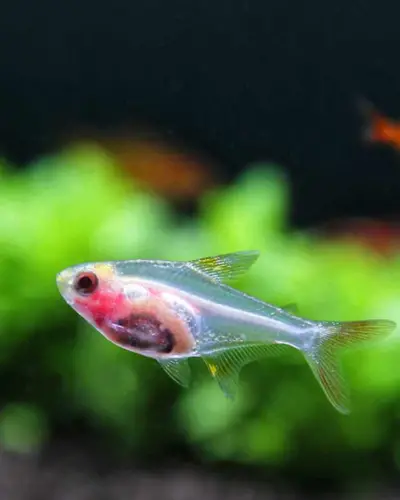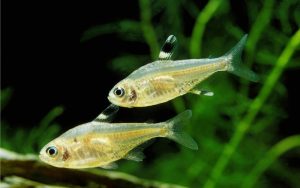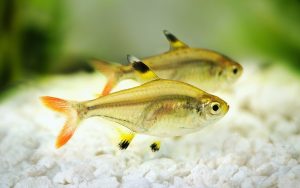How to Breed X Ray Tetras in a freshwater aquarium? The mesmerizing shimmer of pristella maxillaris Tetra fish, with its translucent body and glowing neon stripes, captivates any aquarist. But imagine witnessing the magic of these vibrant fish multiplying right in your tank!
Breeding X-Ray Tetras isn’t just a fascinating experience; it’s a rewarding challenge for any fish enthusiast.
This comprehensive beginner’s guide will equip you with the knowledge and techniques to unlock the secrets of successful X Ray Tetra breeding, taking you from novice to pro in no time.

From choosing the perfect breeding pair to understanding the intricacies of their spawning behavior, we’ll demystify the art of breeding x ray tetras and empower you to cultivate your school of these dazzling aquatic gems.
Ready to dive into the captivating world of Pristella Tetra breeding? Let’s get started!
Table of Contents
ToggleHow to Breed X Ray Tetras in Aquarium?
Breeding x-ray tetras in an aquarium can be a rewarding experience for enthusiasts looking to add unique and fascinating species of tropical fish to their collection. One popular tetra species often bred in captivity is the pristella tetra, also known as pristella maxillaris.
These schooling fish are native to the Amazon River’s coastal waters in South America countries like Guyana. They are known for their transparent body and peaceful behavior in a community tank.
To start breeding pristella tetras, a separate breeding tank with slightly acidic water conditions should be set up, along with fine leaved plants, driftwood, and a soft substrate for egg laying.
X-ray fish are known to scatter their eggs among plants and decorations, so providing ample hiding spots is essential. The eggs will hatch in a few days, and the fry can be fed infusoria, brine, or daphnia in the breeding tank.
It’s essential to keep the tank in dim light and maintain acidic water conditions to ensure the health and survival of the fry. Once they have grown large enough, the young x-ray tetras can be introduced to the main community tank and will thrive alongside other peaceful fish species and invertebrates.
Breeding pristella tetras can be a fun and educational experience for aquarium enthusiasts looking to learn more about this unique tetra species. By providing the right environment and care, x-ray tetras can flourish and add a beautiful touch to any freshwater aquarium.
Expert Tips for X-ray Tetra Fish Breeding (Step-By-Step)
Breeding tetra pristella maxillaris can be an exciting and rewarding experience. Here is a step-by-step guide to help you with the process:
Step 1: Choosing the Right Breeding Pair
- Healthy & Vibrant: Select a pair of X-ray Tetras that are healthy, active, and exhibit vibrant, distinct neon stripes. Avoid fish with dull coloration or any signs of illness.
- Sexing X-ray Tetras: Male X-ray Tetras tend to be slightly smaller and more slender than females, with longer, more pointed fins. Females are plumper and have a somewhat more rounded abdomen.
- Compatible Pair: Observe the fish together before introducing them to the breeding tank. Ensure they interact peacefully and show signs of courtship behavior.
Step 2: Setting Up the Breeding Tank
- Size Matters: A 10-gallon tank is ideal for breeding Pristella Tetras. Ensure the tank is cycled and has a stable water temperature of 78-82°F.
- Soft Water & Plants: X-ray Tetras prefer soft, slightly acidic water with a pH of 6.0-7.0. Dense plant life provides cover and encourages spawning. Java moss, Hornwort, and Amazon swords are excellent choices.
- Spawning Substrate: Provide a fine-grained substrate like sand or gravel. This allows the eggs to settle and prevents them from getting lost or eaten.
Step 3: Conditioning the Breeding Pair
- High-Quality Diet: Feed the breeding pair a high-quality diet of live or frozen foods like brine shrimp, daphnia, and mosquito larvae.
- Enhancing Fertility: Add a breeding booster to their diet, such as Spirulina flakes, to encourage fertility and egg production.
- Spawning Trigger: To induce spawning, gradually reduce the water temperature by a few degrees for a few days, mimicking the natural change of seasons.
Step 4: The Spawning Process
- Courtship Behavior: Male X-ray Tetras will display a zigzag dance around the female, often flaring their fins.
- Egg Deposition: The female will release eggs, which the male fertilizes immediately. Eggs will be scattered among the plants and on the substrate.
- Parental Care: Both parents will display some care but could be more diligent.
Step 5: Caring for the Eggs
- Egg Hatching: Eggs will hatch in about 24-48 hours.
- Fry Care: Newly hatched fry are tiny and need a well-filtered tank with plenty of infusoria or other suitable food sources.
- Feeding: Start with live baby brine shrimp or other small live foods. Gradually transition to larger foods as the fry grows.
Step 6: Raising the Fry
- Water Changes: Perform frequent water changes to ensure good water quality for the growing fry.
- Growth: X-ray Tetra fry proliferates and will develop their characteristic neon stripes in a few weeks.
- Separation: As the fry grows, separate them into larger tanks to prevent overcrowding.
Tips for Pristella Tetra Breeding Success:
- Patience: X-ray fish breeding can be a delicate process. Be patient and observe your fish closely.
- Cleanliness: Maintain impeccable water quality in the breeding tank.
- Nutrition: Provide a varied diet to ensure healthy development.
- Environment: Replicate the natural environment as closely as possible to encourage breeding behavior.
Breeding X ray Tetras is a rewarding experience that allows you to witness the fascinating life cycle of these beautiful fish. By following these steps and paying attention to detail, you can create a thriving breeding program and enjoy the joy of watching your school of vibrant X-ray Tetras flourish in your aquarium. You can succeed in the enchanting world of X-ray tetra pristella breeding with dedication and patience.
Natural Habitat & Water Parameters for Breeding X ray Tetras
X-ray tetras are a unique transparent freshwater species that mimic their natural habitat by preferring a sandy substrate and java fern for breeding.
These stunning neon tetras have a bony internal structure called the Weberian apparatus that allows them to pick up sound waves for a keen sense of hearing.
Breeding x-ray tetras require water parameters similar to their natural habitat, including a pH level of 6.0-7.0 and a temperature of 75-82°F.
A sponge filter and a spawning mop will help provide the necessary conditions for successful breeding. It is essential to remember that the females are generally larger than the males, which will help prevent them from eating the eggs.
Setting Up the Perfect Breeding Tank for X-Ray Tetras
A well-designed breeding tank is crucial for successful X ray Tetra breeding. This section will guide you through creating an optimal environment that encourages spawning, protects eggs, and fosters healthy fry development.
Tank Size:
- Ideal: A 10-gallon tank provides ample space for a breeding pair and their offspring.
- Minimum: A 5-gallon tank can work, but you might need to separate the fry into a larger tank sooner.
Water Parameters:
- Temperature: X-ray Tetras thrive in slightly warm water, aiming for a temperature between 78-82°F. Maintain a consistent temperature for optimal breeding conditions.
- pH: Soft, slightly acidic water with a pH of 6.0-7.0 is ideal for X-ray Tetras.
- Hardness: Low hardness (GH) is preferred for successful breeding. Aim for a GH of 3-5 dGH.
Tank Setup:
- Substrate: Choose a fine-grained substrate like sand or gravel. This helps the eggs settle and prevents them from getting lost or eaten.
- Plants: Dense plant life is essential for spawning and covering the fry. Consider these options:
- Java moss: Provides ample surface area for egg deposition and a hiding place for fry.
- Hornwort: Offers excellent cover for fry and can help absorb excess nutrients.
- Amazon swords: Provide larger, leafy surfaces for the fish to spawn on.
- Floating plants: Create shaded areas and prevent algae growth.
- Filter: Use a sponge filter for gentle water circulation, minimizing disturbances to the eggs and fry.
- Lighting: Moderate lighting is sufficient. Avoid harsh, direct lighting that could overheat the water or stress the fish.
- Décor: Include a few driftwood pieces or rocks for the fish to explore and use as spawning sites. Avoid sharp edges that could injure the fish or fry.
Water Conditioning:
- Dichlorination: Always dechlorinate tap water before adding it to the x-ray tetra’s tank. Use a dechlorinator specifically designed for aquariums.
- Water Changes: Perform regular water changes (25-50% weekly) to maintain good water quality and prevent buildup of harmful substances.
Additional Tips:
- Cycling: Ensure your breeding tank is correctly cycled before introducing the breeding pair. This ensures the tank has a healthy bacterial colony to break down waste and maintain water quality.
- Quarantine: Quarantine any new fish before introducing them to the breeding tank to prevent the spread of diseases.
- Observation: Observe your breeding pair closely for courtship behavior and any signs of stress.
- Patience: X-ray Tetra breeding can take time. Be patient and maintain the optimal environment for success.
Following these guidelines and creating a suitable breeding environment can significantly increase your chances of successfully breeding these captivating neon tetras.
Notice: Getting X-Ray Tetras to spawn is easy, but raising the tiny fry is more challenging.
X-Ray Tetras are known for being easy to spawn, but their fry are delicate and require specific care. Here’s a breakdown of the challenges:
- Predation: Adult X-rays see their eggs as food. Breeders must remove the parents after spawning or use methods to protect the eggs, like spawning mops or marbles.
- Food size: The Fry is incredibly small. They need infusoria or green water with tiny organisms like rotifers for the first few days until they can handle larger foods like baby brine shrimp.
- Water Quality: Sensitive fry requires pristine water conditions. Frequent small water changes and maintaining stable water parameters are crucial.
- Light: Strong light can be harmful to developing fry. Keeping the tank dimly lit for the first few days is recommended.
Raising X-ray Tetra fry requires dedication and close attention to detail. If you’re up for the challenge, many resources are available online and in fishkeeping communities to guide you.
Commonly Asked Questions about X-Ray Tetra Breeding (FAQs)
How many eggs do X-ray tetras lay?
X-ray Tetras are prolific egg scatterers, laying 300-400 eggs simultaneously. Their eggs are tiny and transparent, adhering to vegetation in the aquarium.
How do I get my tetras to breed?
To trigger breeding, isolate healthy tetras in a smaller tank with soft, acidic water (around 77°F)—mimic rain by lowering the water level & adding spawning moss.
What tetras are easy to breed?
Emperor Tetras, Ember Tetras, and Glowlight Tetras are considered easier to breed for beginners due to their willingness to spawn and less demanding fry care.
How many X-ray tetras should be kept together?
A 6-8 X-Ray Tetras school is ideal for a community tank. This allows them to shoal comfortably and feel secure.
How long does it take tetras to lay eggs?
Tetras typically lay eggs within 24-48 hours of being placed in a breeding tank with ideal conditions like soft water, warm temperature, and spawning plants.
Conclusion
In conclusion, breeding X-ray tetras can be rewarding and fascinating for any aquarium enthusiast. These radiant fish, with their translucent bodies and shimmering colors, can add a touch of elegance to any tank. While the breeding process may require patience and careful observation, the joy of watching new generations of X-ray tetras swim gracefully is priceless. Remember to provide optimal water conditions, create suitable hiding spots, and ensure a balanced diet for the adult fish and their fry. Following these tips and maintaining a nurturing environment can increase your chances of successfully breeding X-ray tetras. So, if you’re ready to embark on this adventure, don’t hesitate to explore the wonders of how to breed X ray tetras.
Recommended posts
- X Ray Tetras Fish 101: A Guide to Pristella Maxillaris Care
- Cardinal Neons Tetra fish 101: Cardinal Tetra Comprehensive Guide!
- What Do X-Ray Tetra Eat: (Best Pristella Maxillaris Diet)





